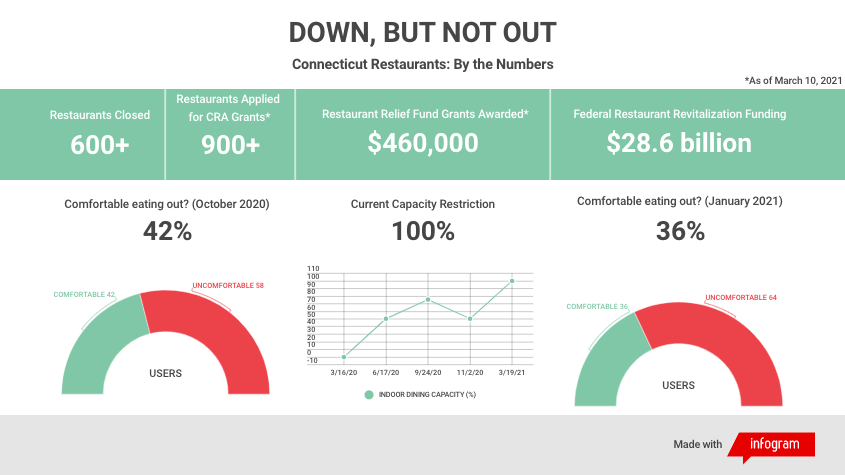By Carson Swick
March 23, 2021
Newswriting II, University of Connecticut
STORRS — Though there is light at the end of the COVID-19 tunnel, the fate of many Connecticut restaurants hangs in the balance.
Since Gov. Ned Lamont first imposed capacity restrictions more than a year ago, restaurants across the state have had to cope with massive revenue losses. By November, such losses had proven to be the end of the road for over 600 restaurants, according to The Hartford Courant.
As that number continues to climb, the demand for relief is greater than ever. On Thursday, March 11, President Joe Biden signed the Restaurant Revitalization Fund, freeing up $28.6 billion in federal grants for restaurant operators across the country.
“[The Restaurant Revitalization Fund] is a large sum of money that will be given as grants to not just restaurants, but caterers and small, private entertainment venues who we also represent as part of our association,” said Emily Garfinkel, operations assistant of the Connecticut Restaurant Association (CRA) in a phone interview. “That is a really big feat; it is the biggest grant we’ve seen yet in this pandemic.”
The Restaurant Revitalization Fund secures funding for the state’s strained service industry, and it comes at a time to complement CRA initiatives like the Restaurant Relief Fund. According to Garfinkel, the Restaurant Relief Fund — which was launched in January — is financed by both DoorDash and private donors. As of Wednesday, March 10, the initiative has awarded $5,000 grants to 92 restaurants statewide.
“We received at least 900 applications from restaurants throughout the state, including ice cream shops, coffee shops, frozen yogurt stands, [and] food trucks,” said Garfinkel. “The association and our educational board went through and verified the applications.”
All the restaurant owners who applied for Restaurant Relief Fund grants were in need, but Garfinkel noted that the CRA was forced to make difficult considerations in awarding the grant money.
“Some of the [grants], we wanted to go to restaurants who were clearly in need, but also that showed they were going to prosper — or least come out of the pandemic all right — as opposed to balancing it with ones who seem that they are about to close, and $5,000 wouldn’t do it for them anyway,” she said.
The $5,000 grants awarded by the Restaurant Relief Fund differ from last year’s federal small business loans, as the money goes directly to business owners instead of mandating payroll contributions for restaurant employees.
But even with the widespread availability of both federal and state aid, Connecticut restaurants are grappling with a much bigger problem: the lack of consumer confidence. A Jan. 11 Morning Consult poll showed that only 36% of all American adults feel comfortable going out to eat — a 6% decrease from the 42% of people who said they would dine out back in October.
Dennis Demos, the general manager of Vernon Diner, located just off Interstate 84 in Vernon, said that his restaurant has been plagued by this decline in consumer confidence.
“There [are] a lot of people that call for takeout who want curbside pickup; they’re too scared to go inside,” Demos said in a phone interview. We sanitize everything, we have sanitizers every 10 feet and we do our best to keep the place as safe and clean as possible. But at the end of the day, a lot of customers are still scared to go in and dine-in. That’s why we have delivery.”
According to Demos, the winter months were the toughest of the pandemic for Vernon Diner, as the outdoor patio closed and the statewide spike in COVID-19 cases deterred many customers from dining in. Still, the diner’s introduction of food delivery via GrubHub and DoorDash last summer has allowed it to remain open and profitable. But other restaurants, particularly those in Connecticut’s more densely populated areas, have not been so fortunate.
“The biggest impact has been in our urban areas: Hartford, New Haven, Stamford,” Garfinkel said. It sounds counterintuitive, because there are more potential customers. But we think a lot of that is due to people’s nerves about being exposed to the virus.”
Lamont’s loosened COVID-19 capacity restrictions, which allow restaurants to operate at 100% capacity, went into effect last Friday. But since the reopening, Connecticut’s most recent seven-day positivity rate sits at 3.3% — the highest since early February — according to The Hartford Courant. Given the transition to increased capacity and the state’s impending vaccine rollout next month, restaurants remain cautiously optimistic about the future.
“I think the fact that we’re going to 100% [capacity] is gonna give the consumers a little bit of relief, but I feel like they’re still gonna be scared,” Demos said. “I don’t think we’re gonna be packed right away. In the summertime is when it’s gonna open; when the nice weather comes, everyone’s gonna want to sit outside. That’s what I really think — I don’t think the 100% [capacity] is really gonna do much right away.”
Interviews conducted: March 10 with Emily Garfinkel, (860) 276‑7209; March 18 with Dennis Demos, (860) 875‑8812

Leave a Reply
You must be logged in to post a comment.